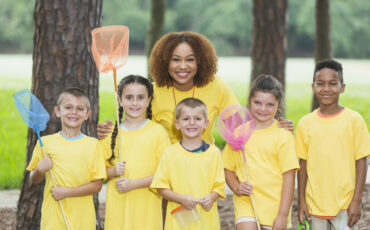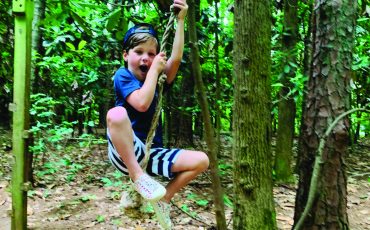Mother Nature’s Playground

by Christa Melnyk Hines
Table of Contents
Transform an ordinary back yard into a captivating, natural wonderland and you’ll harness the curiosity and imagination of your children in a whole new way. A multi-sensory landscape provides your children with an enriching, year-round, fresh-air retreat. Jocelyn Chilvers, a 30-year veteran in landscape design, as well as an artist, teacher and author of the blog “The Art Garden,” suggests that your landscape should include three areas – for active play, interactive play and seasonal observation – and they should evolve with your child’s changing interests.
Active Play
Plan open spaces to accommodate your children’s ages and their favorite activities. While a young child might prefer a sandbox and swing set, an older child might need space for playing croquet or volleyball.
Also, include an area in which the children can do whatever they like. “For my three boys, that means unfettered digging! In fact, they have been working on ‘the crater’ for at least three years now,” says Jamie McIntosh, an award-winning writer and author of the blog “Organic Gardens.”
In addition, an enclosed area encourages imaginative play. “Kids appreciate an area that feels like they are in their own little world,” says Chilvers, whose daughter played dolls for hours under an apricot tree in their back yard. If you live in an area with few mature trees, create structures for shady retreats such as a canvas canopy or a gazebo.
Interactive Learning
Designate a space for you and your children to plant a garden or design a birdhouse together. A low bench for potting plants and a raised garden make it easier for a child to get involved. Make a special place for gloves and gardening tools alongside your potting area.
“Let her select the plants and help her plant them,” Chilvers says. “Take digital photos and make a picture book of the summer.” At the end of the season, reflect and share in the progression of her garden, reviewing pictures of her planting, watering and weeding her growing flowers or vegetables.
 Annette Pelliccio, founder and CEO of The Happy Gardener Inc., whose company provides earth-friendly products to gardeners, says that when her daughters were toddlers she integrated storybook elements in their “play garden,” including a Charlotte’s Web wire in a tree, a cottage playhouse and plants with names like Blue Fairy Clematis, Robin Hood tulips and Ruby Slipper poppies.
Annette Pelliccio, founder and CEO of The Happy Gardener Inc., whose company provides earth-friendly products to gardeners, says that when her daughters were toddlers she integrated storybook elements in their “play garden,” including a Charlotte’s Web wire in a tree, a cottage playhouse and plants with names like Blue Fairy Clematis, Robin Hood tulips and Ruby Slipper poppies.
Now ages 10 and 8, Pelliccio’s daughters planted a serenity rose garden choosing varieties of roses based on what they want in their lives.
“Varieties include Home and Garden, Easy Living, Cha Ching … [and] America. They are painting tiles to hang throughout the garden with words of what we find important, including Peace, Family, Laughter,” Pelliccio says.
Further cultivate an appreciation for the world outside through recycling. “It’s never too early to teach children how to be good environmental stewards,” McIntosh says. “We compost all of our kitchen vegetable scraps and my children like to see what insects are crawling around in the compost bin when we add the scraps.”
Seasonal Observation
Children love to study bees collecting pollen, observe birds searching for worms, search for animal tracks or patiently wait for a butterfly to break out of its chrysalis. “Include features in your garden that allow you and your child to observe nature and seasonal changes throughout the year,” Chilvers says.
Bring calming water elements into your garden and follow the aquatic life cycle of fish and plants. For younger kids, “a self-contained waterfall fountain is safe and inexpensive,” McIntosh says.
Create a bird-feeding station in the winter and consult your state bird field guide to identify the birds that visit your bird feeders.
Plant flowers in the spring that attract bees and butterflies to your garden throughout the summer. In the fall, put the “garden to bed” in preparation for the winter while noting the change of the seasons highlighted in the glory of rich fall colors.

A Multi-Sensory Garden
A garden can satisfy all five of the senses. Plant showy, fast-growing sunflowers or lilies and fragrant herbs like mint and lemon balm. And since children love to pick flowers, McIntosh suggests flowers like snapdragons, pansies, cosmos and marigolds that “respond to picking by producing more blossoms.
“Encourage birdsong in your garden with drought-tolerant coneflowers and zinnias, which attract goldfinches with their seeds,” McIntosh adds.
Children can taste the fruits of their labors if together you plant fruits or vegetables. Thorn-free raspberry or blackberry bushes are a great option. (As a cautionary note, instruct your children to always ask you before eating anything from the garden.)
Create a Wildlife-Friendly Garden
David Mizejewski, an Emory University graduate, naturalist, blogger and author with the National Wildlife Federation’s Certified Wildlife Habitat program, shares these additional tips for attracting wildlife to your back yard:
- Water is one of best ways to attract wildlife, even something as simple as a birdbath. Change the water every few days to make sure the birds have clean water to drink and bathe in and you’ll ensure mosquitoes aren’t breeding in it.
- Plant sunflower seeds indoors in small pots with the kids and then transplant the seedlings outside. The sunny yellow flowers will brighten your yard and provide nectar to bees and butterflies. In late summer, they’ll go to seed and become natural bird feeders for chickadees, goldfinches and other colorful birds.
- Add a nesting box for bluebirds, swallows, chickadees or even wood ducks or screech owls and give your family a great opportunity to witness animal parents taking care of their babies.
- Plant a butterfly garden. Include native wildflowers such as purple coneflower, black-eyed Susan, yarrow, coreopsis and liatris to attract nectar-drinking adult butterflies. Add plants such as milkweed for caterpillars (milkweed is the host plant for monarch butterflies).
- Create a butterfly feeder by putting chunks of watermelon, mashed berries or overripe bananas on a shallow dish in a sunny spot in your yard. Butterflies will stop by to sip up the sweet juices.
- Plant a small tree or large shrub this spring. Native dogwood, fringetree, holly, elderberry, chokeberry, beautyberry and viburnum all have beautiful blooms that attract pollinators and later have berries that feed birds.
- Adopt organic gardening practices and forgo using toxic chemical pesticides and fertilizers. Not only is this better for wildlife, it is safer for your family and pets.







